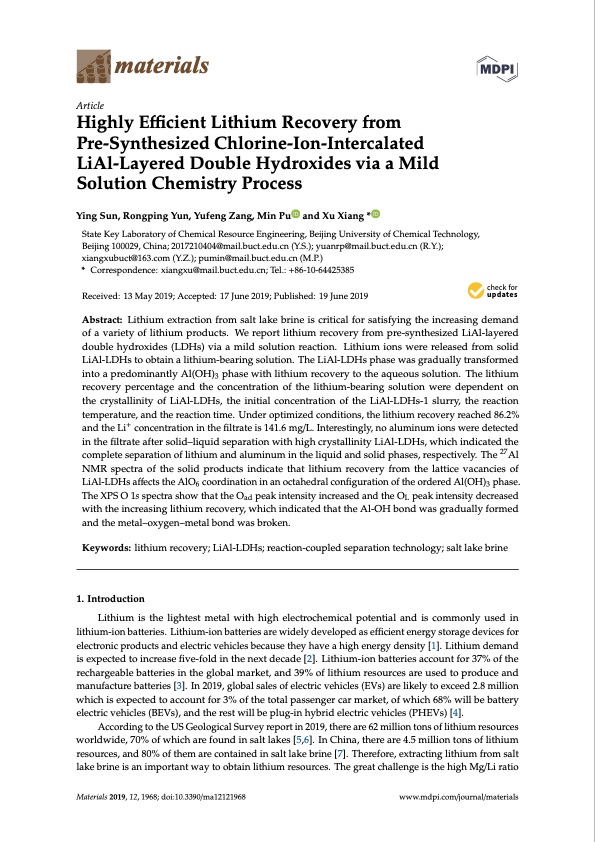
PDF Publication Title:
Text from PDF Page: 001
materials Article Highly Efficient Lithium Recovery from Pre-Synthesized Chlorine-Ion-Intercalated LiAl-Layered Double Hydroxides via a Mild Solution Chemistry Process Ying Sun, Rongping Yun, Yufeng Zang, Min Pu and Xu Xiang * State Key Laboratory of Chemical Resource Engineering, Beijing University of Chemical Technology, Beijing 100029, China; 2017210404@mail.buct.edu.cn (Y.S.); yuanrp@mail.buct.edu.cn (R.Y.); xiangxubuct@163.com (Y.Z.); pumin@mail.buct.edu.cn (M.P.) * Correspondence: xiangxu@mail.buct.edu.cn; Tel.: +86-10-64425385 Received: 13 May 2019; Accepted: 17 June 2019; Published: 19 June 2019 Abstract: Lithium extraction from salt lake brine is critical for satisfying the increasing demand of a variety of lithium products. We report lithium recovery from pre-synthesized LiAl-layered double hydroxides (LDHs) via a mild solution reaction. Lithium ions were released from solid LiAl-LDHs to obtain a lithium-bearing solution. The LiAl-LDHs phase was gradually transformed into a predominantly Al(OH)3 phase with lithium recovery to the aqueous solution. The lithium recovery percentage and the concentration of the lithium-bearing solution were dependent on the crystallinity of LiAl-LDHs, the initial concentration of the LiAl-LDHs-1 slurry, the reaction temperature, and the reaction time. Under optimized conditions, the lithium recovery reached 86.2% and the Li+ concentration in the filtrate is 141.6 mg/L. Interestingly, no aluminum ions were detected in the filtrate after solid–liquid separation with high crystallinity LiAl-LDHs, which indicated the complete separation of lithium and aluminum in the liquid and solid phases, respectively. The 27Al NMR spectra of the solid products indicate that lithium recovery from the lattice vacancies of LiAl-LDHs affects the AlO6 coordination in an octahedral configuration of the ordered Al(OH)3 phase. The XPS O 1s spectra show that the Oad peak intensity increased and the OL peak intensity decreased with the increasing lithium recovery, which indicated that the Al-OH bond was gradually formed and the metal–oxygen–metal bond was broken. Keywords: lithium recovery; LiAl-LDHs; reaction-coupled separation technology; salt lake brine 1. Introduction Lithium is the lightest metal with high electrochemical potential and is commonly used in lithium-ion batteries. Lithium-ion batteries are widely developed as efficient energy storage devices for electronic products and electric vehicles because they have a high energy density [1]. Lithium demand is expected to increase five-fold in the next decade [2]. Lithium-ion batteries account for 37% of the rechargeable batteries in the global market, and 39% of lithium resources are used to produce and manufacture batteries [3]. In 2019, global sales of electric vehicles (EVs) are likely to exceed 2.8 million which is expected to account for 3% of the total passenger car market, of which 68% will be battery electric vehicles (BEVs), and the rest will be plug-in hybrid electric vehicles (PHEVs) [4]. According to the US Geological Survey report in 2019, there are 62 million tons of lithium resources worldwide, 70% of which are found in salt lakes [5,6]. In China, there are 4.5 million tons of lithium resources, and 80% of them are contained in salt lake brine [7]. Therefore, extracting lithium from salt lake brine is an important way to obtain lithium resources. The great challenge is the high Mg/Li ratio Materials 2019, 12, 1968; doi:10.3390/ma12121968 www.mdpi.com/journal/materialsPDF Image | Lithium Recovery Pre-Synthesized Chlorine-Ion-Intercalated

PDF Search Title:
Lithium Recovery Pre-Synthesized Chlorine-Ion-IntercalatedOriginal File Name Searched:
materials-12-01968.pdfDIY PDF Search: Google It | Yahoo | Bing
Product and Development Focus for Infinity Turbine
ORC Waste Heat Turbine and ORC System Build Plans: All turbine plans are $10,000 each. This allows you to build a system and then consider licensing for production after you have completed and tested a unit.Redox Flow Battery Technology: With the advent of the new USA tax credits for producing and selling batteries ($35/kW) we are focussing on a simple flow battery using shipping containers as the modular electrolyte storage units with tax credits up to $140,000 per system. Our main focus is on the salt battery. This battery can be used for both thermal and electrical storage applications. We call it the Cogeneration Battery or Cogen Battery. One project is converting salt (brine) based water conditioners to simultaneously produce power. In addition, there are many opportunities to extract Lithium from brine (salt lakes, groundwater, and producer water).Salt water or brine are huge sources for lithium. Most of the worlds lithium is acquired from a brine source. It's even in seawater in a low concentration. Brine is also a byproduct of huge powerplants, which can now use that as an electrolyte and a huge flow battery (which allows storage at the source).We welcome any business and equipment inquiries, as well as licensing our turbines for manufacturing.| CONTACT TEL: 608-238-6001 Email: greg@infinityturbine.com | RSS | AMP |